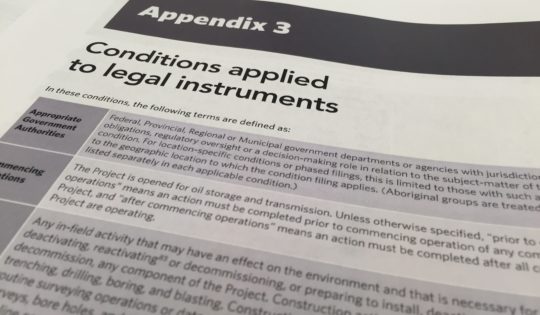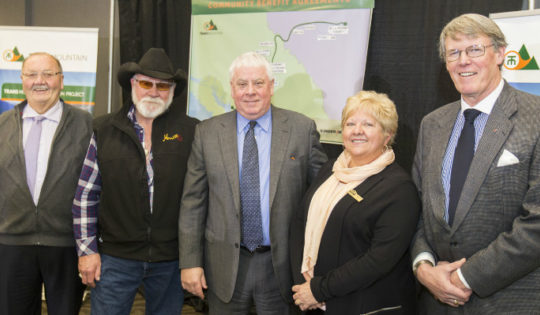The original Trans Mountain Pipeline was built in 1953 and continues to operate safely today. The Expansion is essentially a twinning of this existing 1,150-kilometre pipeline between Strathcona County (near Edmonton), Alberta and Burnaby, BC. It will create a pipeline system with the nominal capacity of the system going from approximately 300,000 barrels per day to 890,000 barrels per day.
On June 18, 2019 the Government of Canada approved the Trans Mountain Expansion Project. The Project is subject to 156 conditions enforced by the Canada Energy Regulator.
Here are some quick facts about the expansion:
- It will be approximately 980 km of new pipeline
- 73 per cent of the route will use the existing right-of-way, 16 per cent will follow other linear infrastructure such as telecommunications, Hydro or highways and 11 per cent will be new right-of-way
- It will include 193 km of reactivated pipeline
- 12 new pump stations will be built
- 19 new tanks will be added to the existing storage terminals in Burnaby (14), Sumas (1) and Edmonton (4)
- Three new berths will be built at Westridge Marine Terminal in Burnaby. Once the new berths are completed and in service, the number of tankers loaded at the Westridge Marine Terminal could increase to approximately 34 per month.
- The existing pipeline will carry refined products, synthetic crude oils, and light crude oils with the capability for heavy crude oils
- The new pipeline will carry heavier oils with the capability for transporting light crude oils
- Engagement with communities, landowners, stakeholders and Indigenous communities has been ongoing since 2012 and will continue through to operation
- Environmental protection plans have been developed along the entire route. Volume 5 and Volume 6 of the Facilities Application cover the environmental assessment and protection planning. We will continue to conduct field studies along the route as required.
- It’s expected to cost approximately $30.9 billion.
- Mechanical completion of the Project is anticipated to occur in the third quarter of 2023.
- It will create benefits including new short- and long-term jobs, job-related training opportunities and increases in taxes collected by all three levels of government
- To date, Trans Mountain and our contractors have hired approximately 35,329 people to work on the Expansion Project.
Why expand?
The Trans Mountain Expansion Project will help make sure Canada gets full value for its oil. Everyone will benefit. Workers will benefit during the $30.9* billion construction project. Oil producers will earn more revenue for their product. Government will collect more tax revenue from oil. These revenues contribute to services that benefit all Canadians.
Currently, nearly all the oil produced in Western Canada goes to one market, the United States Midwest. However, there’s a limit to how much oil this market needs. For much of the last decade, Canada has been selling into the United States at a discount to the world price for similar oil products.
The simple truth is that Canada’s oil will fetch a better price if we give ourselves the option of shipping more of it via Trans Mountain’s Pacific tidewater terminal in Burrard Inlet. Canada will earn more on every barrel of oil that’s piped west compared to those sold to our existing customers in the United States Midwest market, a differential that exists regardless of the price of oil.
With oil sands production expanding in Alberta in the years ahead, new markets and new opportunities are emerging. As countries in Asia Pacific begin to develop the same quality of life we enjoy here in Canada, they need to secure sources of energy. Canada is a natural trading partner for these countries, and with an expanded Trans Mountain Pipeline system, we will be in a position to provide for their growing needs for years to come.
Who’s involved?
When oil producers told us they could reach new markets by expanding the capacity of North America’s only pipeline with access to the West Coast, Trans Mountain proposed the Expansion Project.
These oil producers have made significant 15- and 20-year commitments that add up to roughly 80 per cent of the capacity in the expanded Trans Mountain Pipeline:
- BP Canada Energy Trading Company
- Canadian Natural Resources Limited
- Cenovus Energy Inc.
- ConocoPhillips Company
- Imperial Oil Limited
- MEG Energy Corp.
- Parkland Corporation
- PetroChina Canada Limited
- Suncor Energy Marketing Inc.
- Marathon Petroleum Canada Trading & Supply ULC
Pipeline Alternatives
Pipelines are proven to be the safest and most efficient method to move petroleum products over great distances on land. Petroleum products can also be shipped by tanker trucks or railcars.

Every day, member companies of the Canadian Energy Pipeline Association (CEPA) move enough crude oil and petroleum products through pipelines to fill 15,000 tanker truckloads and 4,200 railcars. The existing Trans Mountain pipeline system moves the equivalent of about 1,400 tanker truckloads or 441 tanker railcars daily. Expanding the Trans Mountain pipeline results in safer, more efficient and more economic shipment of oil between Alberta and BC.
Previous Expansion
This is not the first expansion of the Trans Mountain line. In fact, since operation began in 1953, the capacity of the pipeline system has been increased numerous times, with the initial expansion in 1957. The most recent expansion project took place between 2006 and 2008 with the construction of 13 new pump stations and modifications to existing stations. Also during this time, the Anchor Loop project added 160 kilometres of new pipe through Jasper National Park and Mount Robson Provincial Park between Hinton, Alberta and Hargreaves, BC.









